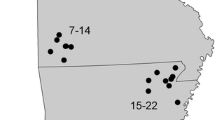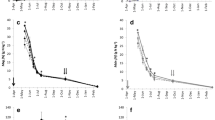Abstract
Research efforts have recently been increasing to evaluate giant miscanthus (Miscanthus × giganteus L.) as a bioenergy feedstock and to develop recommendations for efficient management practices. The objectives of this study were to evaluate effects of nitrogen (N) and phosphorus (P) fertilization on the yield and nutrient removal of giant miscanthus and the change in soil nutrient concentration during establishment of giant miscanthus in the Piedmont and Mountain Regions of North Carolina. Research sites were established at Mills River and Oxford, NC, in 2008 and 2009, respectively. Yield and tissue nutrient content were determined after senescence. Giant miscanthus produced biomass dry yields of up to 24 Mg ha−1 during the third growing season. Fertilization with 45 kg N ha−1 increased yield by 46 % in 2010 at Oxford, but did not affect yield at Oxford in 2009 or at Mills River from 2008 to 2010. Fertilization with 147 kg P ha−1 increased yield by 32 % in 2008 at Mills River, but did not affect yield in 2009 or 2010 at either site. Mehlich-3 P concentration in the upper 20 cm of soil decreased after initial P applications, with no changes in the 0 P control plots detected during this study. Giant miscanthus successfully established at Mills River and Oxford, NC with minimal N and P fertilizer inputs on soils with low initial P concentration.





Similar content being viewed by others
References
Heaton EA, Dohleman FG, Long SP (2008) Meeting US biofuel goals with less land: The potential of miscanthus. Glob Chang Biol 14:2000–2014
Linde-Laursen I (1993) Cytogenetic analysis of Miscanthus × giganteus, an interspecific hybrid. Hereditas 119:297–300
Himken M, Lammel J, Neukirchen D, Czypionka-Krause U, Olfs H (1997) Cultivation of miscanthus under west European conditions: Seasonal changes in dry matter production, nutrient uptake and remobilization. Plant Soil 189:117–126
Jones MB, Walsh M (2001) Miscanthus for energy and fibre. James & James, London
Propheter JL, Staggenborg S (2010) Performance of annual and perennial biofuel crops: nutrient removal during the first two years. Agron J 102:798–805
Beale CV, Long SP (1997) Seasonal dynamics of nutrient accumulation and partitioning in the perennial C4-grasses Miscanthus × giganteus and Spartina cynosuroides. Biomass Bioenergy 12:419–428
Heaton EA, Dohleman FG, Long SP (2009) Seasonal nitrogen dynamics of Miscanthus × giganteus and Panicum virgatum. GCB Bioenergy 1:297–307
Cadoux S, Riche AB, Yates NE, and Machet J (201) Nutrient requirements of Miscanthus × giganteus: conclusions from a review of published studies. Biomass Bioenergy. 38:14–22
Boehmel C, Claupein W, Lewandowski I (2008) Comparing annual and perennial energy cropping systems with different management intensities [electronic resource]. Agric Syst 96:224–236
Cosentino SL, Copani V, Foti S, Patane C, Sanzone E (2007) Effects of soil water content and nitrogen supply on the productivity of Miscanthus × giganteus Greef et Deu. in a Mediterranean environment [electronic resource]. Ind Crops Products 25:75–88
Ercoli L, Bonari E, Masoni A, Mariotti M (1999) Effect of irrigation and nitrogen fertilization on biomass yield and efficiency of energy use in crop production of miscanthus. Field Crops Res 63:3–11
Jacks-Sterrenberg I (1995) Investigations on yield physiology of Miscanthus sinensisanderss. with regard to its use as an energy plant. Untersuchungen zur ertrags physiologie von Miscanthus sinensis anderss. hinsichtlich einer verwendung als energiepflanze. Justus-Liebig-Universität, Fachbereich Agrarwissenschaften und Umweltsicherung, Giessen, Germany
Beuch S (1998) Zumeinfluß des anbaus und der biomassestruktur von Miscanthus × giganteus (GREEF et DEU.) auf den nährstoffhaushalt und dieorganischebodensubstanz. 163
Bullard MJ, Christian DG, Wilkins C (1996) The potential of graminaceous biomass crops for energy production in the UK: an overview. p. 592. In: Ferrero GL, Henius UM, Hultberg S, Sachau J, Wiinblad M (eds) Biomass for energy and the environment. Proceedings of the Ninth European Bioenergy Conference, Copenhagen, Denmark. 1996. Pergamon, New York
Christian DG, Yates NE, Riche AB (2008) Growth, yield and mineral content of Miscanthus × giganteus grown as a biofuel for 14 successive harvests [electronic resource]. Ind Crops Products 28:320–327
Clifton-Brown JC, Breuer J, Jones MB (2007) Carbon mitigation by the energy crop, miscanthus. Glob Chang Biol 13:2296–2307
Danalatos NG, Archontoulis SV, Mitsios I (2007) Potential growth and biomass productivity of Miscanthus × giganteus as affected by plant density and N-fertilization in central Greece. Biomass Bioenergy 31:145–152
Heaton EA, Voigt T, Long SP (2004) A quantitative review comparing the yields of two candidate C4 perennial biomass crops in relation to nitrogen, temperature and water. Biomass Bioenergy 27:21–30
Jorgensen U (1996) Miscanthus yields in Denmark. p. 48. In G.L. Ferrero, U.M. Henius, S. Hultberg, J. Sachau and M. Wiinblad (eds.) Biomass for energy and the environment. Proceedings of the Ninth European Bioenergy Conference, Copenhagen, Denmark. 27 June 1996. Pergamon, New York
Jorgensen U (1997) Genotypic variation in dry matter accumulation and content of N, K, and Cl in miscanthus in Denmark. Biomass Bioenergy 12:155
Schwarz KU, Schung E (1993) Ertragsentwicklung bei mehrjährigen Beständen von Miscanthus × giganteus. Mitt Ges Pflanzenbauwiss 6:125–128
Strullu L, Cadoux S, Preudhomme M, Jeuffroy M, Beaudoin N (2011) Biomass production and nitrogen accumulation and remobilisation by Miscanthus × giganteus as influenced by nitrogen stocks in belowground organs. Field Crops Res 121:381–391
Miguez FE, Bollero GA, Long SP, Villamil MB (2008) Meta-analysis of the effects of management factors on Miscanthus × giganteus growth and biomass production [electronic resource]. Agric For Meteorol 148:1280–1292
Maughan M, Bollero G, Lee DK, Darmody R, Bonos S, Cortese L, Murphy J, Gaussoin R, Sousek M, Williams D, Williams L, Miguez F, Voigt T (2012) Miscanthus × giganteus productivity: the effects of management in different environments. GCB Bioenergy 4:253–265
Hardy DH, Tucker MR, and Stokes CE (2009) Crop fertilization based on North Carolina soil tests. North Carolina Department of Agriculture and Consumer Services, Agronomic Division, Raleigh, NC
Mehlich A (1984) Mehlich 3 soil test extractant: a modification of Mehlich 2 extractant. Commun Soil Sci Plant Anal 15:1409–1416
Mehlich A (1976) New buffer pH method for rapid estimation of exchangeable acidity and lime requirement of soils. Commun Soil Sci Plant Anal 7:637–652
LACHAT (2013) Methods list for automated ion analyzers. http://www.lachatinstruments.com/applications/methods.asp. Accessed 26 Sept. 2013
SAS (2009) SAS/STAT 9.2 User's guide, 2nd ed. http://support.sas.com/documentation/cdl/en/statug/63033/HTML/default/viewer.htm#titlepage.htm. Accessed 26 Sept. 2013
Kaack K, Schwarz KU (2001) Morphological and mechanical properties of miscanthus in relation to harvesting, lodging, and growth conditions. Ind Crops Products 14:145–154
Cosentino SL, Sanzone E, Mantineo M, Copani V, D'Agosta GM (2006) First results on evaluation of Arundo donax L. clones collected in southern Italy [electronic resource]. Ind Crops Products 23:212–222
Schwarz H, Ruckenbauer P, Ehrendorfer K, Liebhard P (1994) The effect of fertilization on yield and quality of Miscanthus sinensis 'giganteus'. Ind Crops Products 2:153–159
Miguez FE, Zhu X, Humphries S, Bollero GA, Long SP (2009) A semimechanistic model predicting the growth and production of the bioenergy crop Miscanthus × giganteus: description, parameterization and validation. GCB Bioenergy 1:282–296
Clifton-Brown JC, Lewandowski I, Andersson B, Basch G, Christian DG, Kjeldsen JB, Jorgensen U et al (2001) Performance of 15 Miscanthus genotypes at five sites in Europe. Agron J 93:1013–1019
Christian DG, Haase E (2001) Agronomy of miscanthus. p. 21. In: Jones MB, Walsh M (eds) Miscanthus for energy and fibre. James & James, London, UK
Neukirchen D, Czypionka-Krause U, Olfs HW, Himken M, Lammel J (1999) Spatial and temporal distribution of the root system and root nutrient content of an established miscanthus crop. Eur J Agron 11:301–309
Eckert B, Stoffels M, Hartmann A, Halbritter A, Weber OB, Kirchhof G (2001) Azospirillum doebereinerae sp. nov., a nitrogen-fixing bacterium associated with the C4-grass miscanthus. Int J Syst Evol Microbiol 51:17–26
Lewandowski I, Schmidt U (2006) Nitrogen, energy and land use efficiencies of miscanthus, reed canary grass and triticale as determined by the boundary line approach. Agric Ecosyst Environ 112:335–346
Newman YC, Vendramini JMB, Rechcigl JE, Sollenberger LE, Silveira ML, Agyin-Birikorang S, Adjei MB, Scholberg JM (2009) Nitrogen fertilization effect on phosphorus remediation potential of three perennial warm-season forages [electronic resource]. Agron J 101:1243–1248
Hussaini MA, Ogunlela VB, Ramalan AA, Falaki AM (2008) Mineral composition of dry season maize (Zea mays L.) in response to varying levels of nitrogen, phosphorus and irrigation at Kadawa, Nigeria. World J Agric Sci 4:775–780
Khan NH, Raja MI, Tahir GR (1980) Interaction studies on nitrogen, phosphorus and zinc application to corn under field conditions. Pak J Agric Res 1:119–124
Christian DG, Poulton PR, Riche AB, Yates NE, Todd AD (2006) The recovery over several seasons of 15 N-labelled fertilizer applied to Miscanthus × giganteus ranging from 1 to 3 years old. Biomass Bioenergy 30:125–133
Gilliam JW (2011) Nutrients in North Carolina soils and waters. http://www.soil.ncsu.edu/about/century/nutrientsinNC.html. Accessed 26 Sept. 2013
Acknowledgments
This study was funded by the Biofuels Center of North Carolina, in cooperation with the North Carolina Agricultural Research Service and North Carolina Agricultural Experiment Station. We appreciate the cooperation of the NC Department of Agriculture and the efforts of Dwayne Tate, Tom Eaker, Jeremy Smith, Darren Touchell, and Collin Suttles to conduct the field operations of the study. We also acknowledge the supervision and staff at the Mountain Horticultural Crops Research Station and the Oxford Tobacco Research Station for their assistance.
Disclaimer
Trade or manufacturers’ names mentioned are for information only and do not constitute endorsement, recommendation, or exclusion by North Carolina State University.
Author information
Authors and Affiliations
Corresponding author
Rights and permissions
About this article
Cite this article
Haines, S.A., Gehl, R.J., Havlin, J.L. et al. Nitrogen and Phosphorus Fertilizer Effects on Establishment of Giant Miscanthus. Bioenerg. Res. 8, 17–27 (2015). https://doi.org/10.1007/s12155-014-9499-4
Published:
Issue Date:
DOI: https://doi.org/10.1007/s12155-014-9499-4




